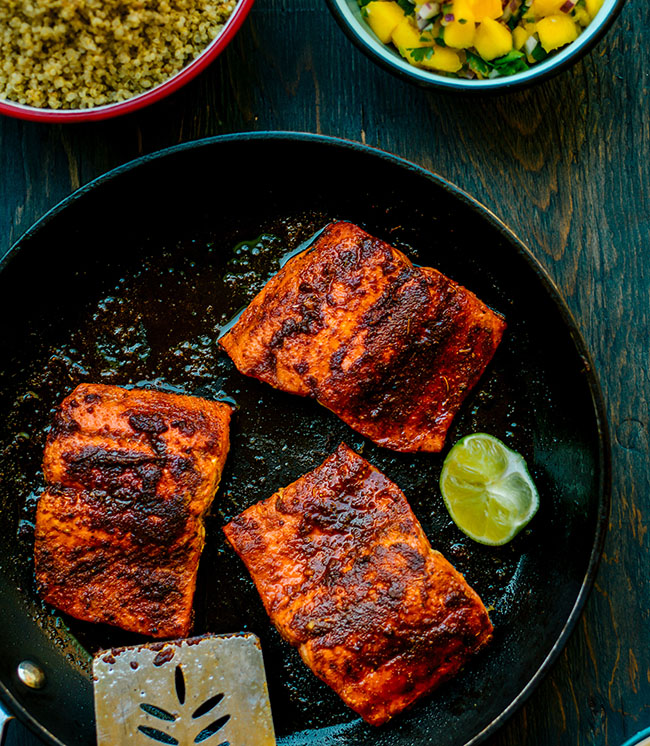
Sockeye Salmon. Photo: Courtesy of Bristol Bay Sockeye
Chinook, coho, chum, sockeye, pink — does this sound like a melodic rhythm? No, these are not the names of songs, chants, or dances. But they are music to salmon lovers’ ears. These are the five types of salmon that are found in North American waters and of the seven in the entire Pacific…
Unlocking the Mysteries of Salmon
Chinook, or king, are the granddaddies of the group. They weigh around 125 pounds with pink being the smallest in the crowd, weighing in at 3 to 5 pounds.
Coho, or silver salmon, a lighter, milder salmon, isn’t as fatty as king salmon and, therefore, has fewer calories. King has 200 calories for a 3-ounce serving, and Coho has 120.
Deep red in color, chum, also called dog or keta salmon, is lighter and less oily than king and sockeye.
Sockeye ranges in size from 2 feet to 2 feet 9 inches and is noted for its deep red flesh, firm texture, and authentic wild taste. It’s considered the most flavorful of all the types and is perfect for grilling, baking, and even raw in sushi-type recipes.
All salmon is nutritious and a healthy choice. It’s low in calories. A 4-ounce serving has around 200 calories. The fish is rich in omega-3 fatty acids and is touted as helpful in the prevention of heart disease, rheumatoid arthritis, and depression. At the same time, salmon is low in saturated fats while being vitamin-rich by containing vitamins A, C, D, and E, niacin, and vitamin B-12.
Give Sockeye a Try
If you are stumped or overwhelmed by the choices of salmon at your local fish market, you might want to give sockeye a try. You won’t be disappointed.
Try sockeye cubed into a refreshing salmon poke bowl, grilled sockeye salmon burgers with rhubarb chutney, or sockeye salmon citrus veggie skewers with herbed yogurt dipping sauce.
Find more recipes, cooking tips, and information about the fishermen of Bristol Bay at BristolBaySockeye.org.

Bristol Bay Sockeye Salmon Quinoa Taco Bowls. Photo: Recipe courtesy of Bristol Bay Sockeye Salmon
Bristol Bay Sockeye Salmon Fish Taco Quinoa Bowls with Mango Salsa & Black Beans
Makes 3 to 4 servings
- For the mango salsa:
- 1 large ripe mango, cubed
- 1/2 cup red onion, diced
- 2 tablespoons jalapeno, minced
- 1/2 cup cilantro, finely chopped
- 1 lime, juiced
- Salt
- For the lime crema:
- 1/2 cup sour cream
- 1/4 cup milk, for thinning
- 1 lime, juiced
- 3/4 teaspoon garlic powder
- Salt to taste
- For the salmon:
- 1 pound sockeye salmon, pin bones and skin removed, cut into four fillets
- Salt and pepper
- 2 tablespoons avocado oil for the pan
- 1 teaspoon chili powder
- 1 teaspoon cumin
- 1 teaspoon sugar
- For the bowls:
- 1 cup quinoa, steamed
- 2 cups black beans, heated through
- 2 cups cabbage, shredded
- 1 avocado, sliced
- 1 lime, cut into wedges
For the mango salsa:
In a medium bowl, add the mango, red onion, jalapeño, and cilantro. Squeeze lime juice over top, season with salt, and stir to combine. Cover and refrigerate until ready to serve.
For the lime crema:
In a small bowl, whisk together the sour cream, milk, lime juice, and garlic powder until smooth and combined. More milk (up to ¼ cup) can be added as needed to thin the mixture so that it is pourable consistency. Season generously with salt. Cover and refrigerate until ready to serve.
For the salmon:
Heat a heavy-bottomed skillet to medium-high heat. Add the avocado oil to the pan. Pat each fillet dry and season each with salt and pepper. In a small bowl, stir together the chili powder, cumin, and sugar. Sprinkle the seasoning mixture over each fillet to coat, patting the seasoning down so that it adheres to the fish. Sear the salmon fillets in the hot pan, about 2-3 minutes per side for medium (cooking times will vary depending on the thickness of your fillets), being careful not to overcook.
To assemble the bowls:
In each bowl, layer the ingredients beginning with a base of quinoa, followed by black beans, then cabbage. Top the cabbage with the salmon fillet. Top the salmon fillet with a generous portion of mango salsa. Drizzle the entire bowl with lime crema. Serve with avocado slices and lime wedges and your favorite hot sauce on the side.











